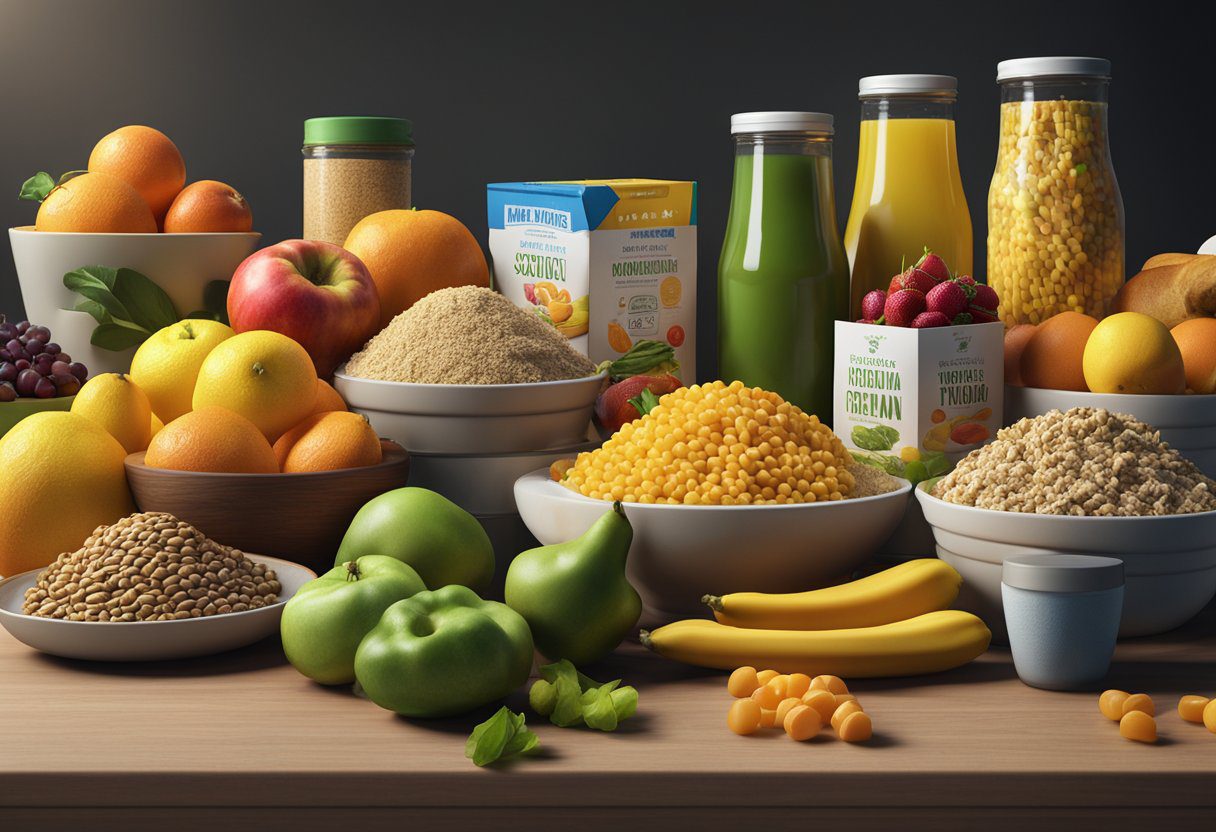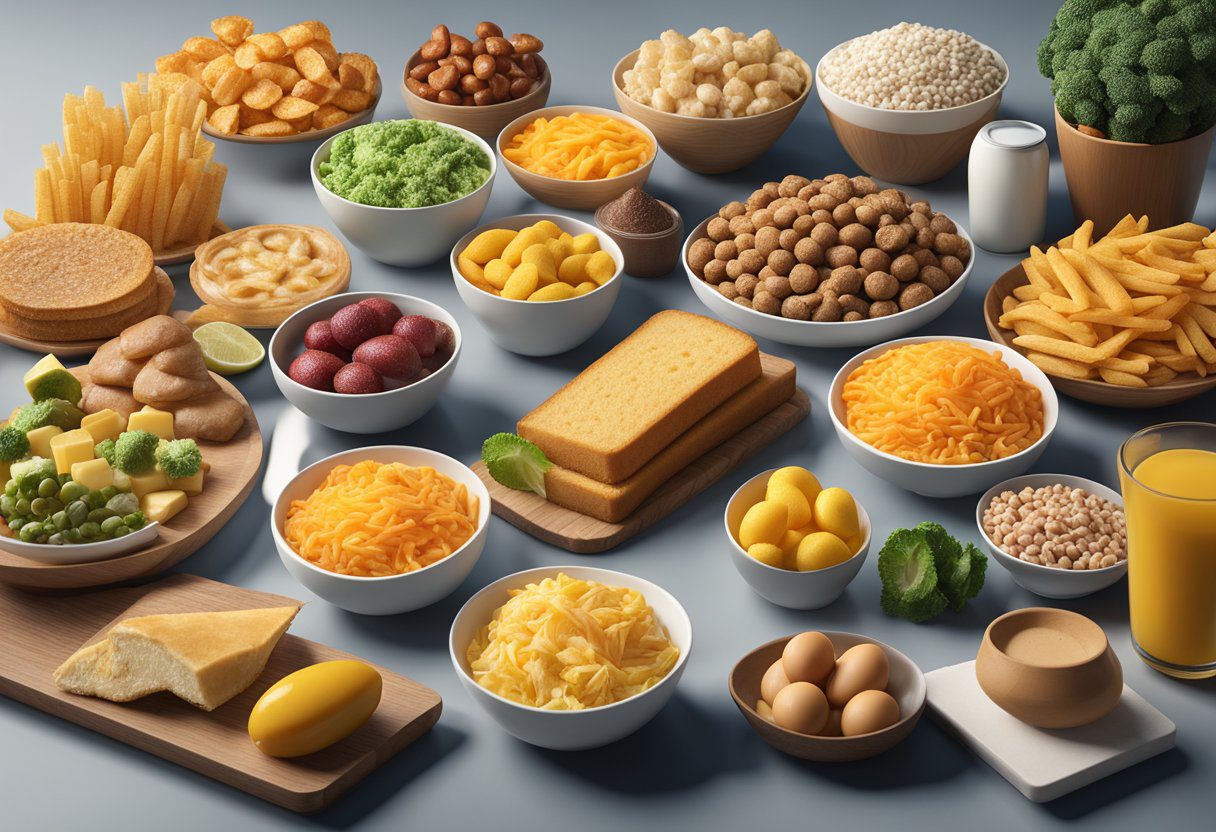Ultra-processed foods have become a staple in diets worldwide, but their impact on health is increasingly scrutinized. Characterized by high levels of sugar, fat, and salt, along with additives like preservatives, flavorings, and colorings, these foods are attractive for their convenience and palatability. However, the consumption of these foods has been linked to various adverse health outcomes, challenging individuals to reconsider their dietary choices.

Recent studies have shed light on the intricate relationship between ultra-processed foods and overall health. The increased presence of these foods in modern diets corresponds with a rise in obesity, heart disease, and diabetes, conditions that burden healthcare systems globally. The findings urge a closer look at our food choices and highlight the need for more thorough scientific exploration to inform better dietary guidelines and consumer awareness.
Key Takeaways
- Ultra-processed foods are high in additives and linked to poor health outcomes.
- Scientific research suggests a need for revised dietary guidelines.
- The relationship between diet, health, and ultra-processed foods warrants further investigation.
Identification of Ultra-Processed Foods

Understanding how to identify ultra-processed foods is essential for making informed dietary choices. This section will guide you through the main features that characterize these foods and the classification system used to categorize them.
Defining Characteristics
Ultra-processed foods typically contain ingredients that are not used in culinary preparations. Instead, these foods are created from substances extracted from foods, such as oils, fats, sugar, starch, and proteins. They often include additives like artificial colors, flavors, preservatives, and sweeteners. Their characteristics differentiate them from minimally processed foods, which have undergone simple processing methods such as freezing, boiling, or drying. Conversely, ultra-processed foods are formulations made mostly or entirely from substances derived from food and additives, with little if any intact minimally processed food.
A key feature of ultra-processed foods is that they are often designed to be highly palatable, convenient, and have a long shelf life. They are typically ready-to-eat or require minimal preparation. Additionally, such foods are often aggressively marketed and high in calories, sugar, fat, and salt.
NOVA Classification System
The NOVA classification system categorizes foods based on the extent and purpose of processing, rather than in terms of nutrients. The framework encompasses four groups:
- Unprocessed or minimally processed foods: These foods include fresh, dried, ground, chilled, frozen, pasteurized, or fermented staple foods like fruits, vegetables, rice, pasta, eggs, meat, fish, and milk.
- Processed culinary ingredients: These are ingredients extracted from foods or from nature such as oils, fats, sugar, salt, and starches used to season and cook.
- Processed foods: They are made by adding salt, oil, sugar, or other substances from group 2 to group 1 foods. Examples include canned fish, fruits in syrup, cheeses, and freshly made bread.
- Ultra-processed foods: This group is the focus of our discussion. It includes soft drinks, sweet or savory packaged snacks, reconstituted meat products, pre-prepared frozen dishes, and other products typically containing additives and little, if any, intact group 1 foods.
The NOVA system helps distinguish between foods like a processed food can of whole tomatoes and an ultra-processed microwaveable ready meal. One of the system’s key contributions is its emphasis on the role of food processing in nutrition and health, notably within contexts such as the US, where ultra-processed foods are prevalent.
Nutritional Aspects

Ultra-processed foods often have a significantly altered nutritional profile in comparison with minimally processed foods. They tend to be higher in added sugar, lower in fiber, and contain various additives that affect their dietary quality.
Macronutrients and Micronutrients
Ultra-processed foods are frequently high in carbohydrates and sugars, which can contribute to an increased intake of calories. They typically contain lower levels of essential nutrients such as fiber, vitamins, and minerals. Studies have shown that high consumption of these foods is linked to a reduced presence of vitamin B6 and vitamin K in the diet. The protein content in ultra-processed foods is often lower than its minimally processed or unprocessed counterparts. These foods also tend to be rich in saturated fat, which is a type of fat associated with negative health outcomes when consumed in excess.
The Role of Additives
Additives in ultra-processed foods, such as preservatives, colorings, flavorings, and emulsifiers, are used to enhance taste, appearance, and texture, as well as to increase shelf life. While these additives are considered safe in regulated amounts, the long-term health effects of consuming a diet high in these substances are not fully understood. Consumers are often advised to be cognizant of the types of additives present in their food choices.
Comparison with Minimally Processed Foods
Minimally processed foods are those that have undergone only minor processing, retaining most of their inherent nutrition. They tend to have a more balanced amount of nutrients, including vitamins, minerals, and fiber, while often being lower in sugar and fat. It is suggested that replacing ultra-processed foods with minimally processed alternatives can lead to better overall nutrient intake and may contribute to better health. A diet rich in minimally processed foods provides a variety of essential nutrients required for maintaining a healthy body.
Health Implications

The consumption of ultra-processed foods has been associated with various adverse health outcomes, including an increased risk of obesity, chronic diseases such as type 2 diabetes and cardiovascular conditions, and potential impacts on mental health.
Obesity and Weight Gain
Ultra-processed foods are high in calories, sugars, unhealthy fats, and salt, which can lead to excessive calorie intake and weight gain. Studies have shown that these foods are engineered to promote overeating, contributing significantly to the obesity epidemic. The link between ultra-processed foods and obesity is particularly concerning.
Chronic Diseases and Mortality
The regular intake of ultra-processed foods is associated with an increased risk of chronic diseases. These include cardiovascular disease, type 2 diabetes, and some cancers. Such foods are often low in nutrients and high in ingredients that contribute to cardiometabolic risk factors. Research has indicated a potential connection between consumption of these foods and higher rates of mortality.
Mental Health
There is a growing body of evidence linking poor dietary patterns, characterized by high consumption of ultra-processed foods, with deteriorations in mental health. Issues such as anxiety and depression have been observed in individuals with diets high in these types of foods. The impact of ultra-processed foods on mental health requires further attention and research, considering the complex nature of mental health disorders.
Dietary Patterns and Ethnic Variations

The consumption of ultra-processed foods and the dietary patterns associated with it vary significantly around the world, influenced by demographic, cultural, and ethnic factors.
Global Consumption Trends
Globally, there is an upward trend in the consumption of ultra-processed foods, which has been linked to growing obesity rates. In the UK, for instance, research published in the BMJ indicates a discernible rise in consumption, particularly among younger demographics. Studies from Brazil and Sweden show varying levels of processed food intake, reflecting the cultural differences in diet. Countries like Australia and the US have also reported high consumption levels, contributing to discussions on the impact of dietary choices on public health.
Demographic and Cultural Differences
Demographics play a crucial role in defining dietary patterns. In multicultural societies, such as the US, ethnic variations in diet are evident. For instance, studies point out that traditional food practices among Indigenous and ethnic minority groups are at risk due to the dominance of processed foods in the market. Cultural differences can dictate the types or quantities of processed foods consumed, which in turn can impact health outcomes. Therefore, it is imperative to understand these demographic nuances and promote culturally sensitive nutritional guidelines.
Scientific Evidence

The investigation into ultra-processed foods reveals consistent associations with various adverse health conditions. The body of evidence largely stems from observational studies, yet it is imperative to consider the inherent limitations of such research in drawing definitive cause-and-effect conclusions.
Observational Studies and Meta-Analyses
Observational studies have indicated a strong association between the consumption of ultra-processed foods and several non-communicable diseases. High intake of these foods has been consistently linked with an increased risk of obesity, heart disease, and diabetes. Evidence from these studies suggests that diets high in ultra-processed foods can lead to increased inflammation, which is a known contributing factor to these health conditions.
In addition to individual observational studies, comprehensive meta-analyses have combined data to provide a broader perspective. For instance, a systematic review and meta-analysis of dietary patterns has clarified the correlation between ultra-processed foods and deteriorating health status. These meta-analyses have been instrumental in corroborating the findings across different populations and dietary habits.
Limitations of Current Research
While the associations found in these observational studies are significant, they are not equivalent to causation. One major limitation is the potential for confounding factors that observational studies cannot wholly eliminate. Health outcomes could be influenced by a myriad of other variables, such as genetic predispositions or overall lifestyle choices, that are challenging to account for fully.
Moreover, many studies rely on self-reported data, which can introduce biases and inaccuracies. Nutritionists and the International Agency for Research on Cancer caution against over-interpreting results without considering these limitations. They advocate for controlled experimental studies to establish a more precise understanding of cause and effect. The body of scientific evidence therefore necessitates cautious interpretation and suggests a need for more rigorous research methodologies to solidify the findings observed.
Consumer Behavior and Industry Response

The interplay between consumer behavior and industry offerings is critical in understanding the dynamics surrounding ultra-processed food consumption. Industry response to consumer demands has resulted in increased availability and targeted marketing of these products, while regulatory measures attempt to mediate the health impacts.
Marketing and Availability
The food industry has levered marketing to cater to the convenience sought by consumers, leading to the proliferation of ultra-processed foods such as soft drinks, salty snacks, and fast food. With higher calories and significant sodium, these products are widely available in stores. For instance, the strategic placement of potato chips and hot dogs ensures they are easily accessible to shoppers.
Consumer Attitudes and Beliefs
Consumers’ perceptions of ultra-processed foods vary, with some considering them an acceptable part of their diet, while others are more health-conscious, seeking items with less processed culinary ingredients and more fibre. There’s a noted trend in snacking preferences, with snacks high in oil and calories being chosen for their taste and convenience over nutrient-dense alternatives.
Regulatory Measures
Regulatory bodies like the World Health Organization advocate for diets lower in ultra-processed foods due to their impact on health. Strategies implemented often include mandatory nutrition labeling, education campaigns promoting whole foods over items like salty snacks and soft drinks, and taxing products high in fats, sodium, and sugars to discourage excessive consumption.
Advancements in Food Processing

Recent advancements in food processing have significantly altered the way food items are preserved, enhanced, and prepared for consumption. They have notably impacted the efficiency of production and the nutritional profile of processed foods.
Technological Innovations
Technological innovations in food processing are primarily centered around improving the efficiency and safety of food production. Industrial processes such as high-pressure processing (HPP) and pulsed electric fields (PEF) have revolutionized preservation techniques, maintaining the freshness of foods similar to canned vegetables without the need for excessive heat that can degrade quality. Drying methods have evolved, with spray drying and freeze drying enabling the production of powders and dehydrated food, preserving flavors and increasing shelf life.
Advances in packaging play a crucial role in maintaining the integrity of food products—active packaging extends the shelf life of foods, while intelligent packaging can communicate the quality of the food inside. Additionally, incorporation of food additives to processed foods, while sometimes controversial, can enhance taste, appearance, and preserve the nutrient value, as seen in enriched frozen meals.
Improving Nutritional Quality
Improvements in the nutritional quality of processed foods are largely attributed to a deeper understanding of health and nutrition. Producers are now adding ingredients that enhance the nutrient profile, such as vitamins and minerals, directly compensating for potential losses during processing or enhancing foods beyond their natural nutritional content.
Companies are also responding to consumer demand for healthier options by reducing negatives such as energy density, saturated fats, and sugars, while increasing positive attributes like fiber content and added ingredients that provide functional benefits, like omega-3 fatty acids.
The NOVA classification system, which groups foods according to the extent and purpose of their processing, has become a guiding framework for improving product formulation to align better with nutritional guidelines. As a result, many producers are revisiting their industrial processing techniques to create products that fit into a more nutritionally favorable category within the NOVA system.
Guidelines and Recommendations

In addressing the challenges posed by ultra-processed foods (UPFs), various public health policies and dietary guidelines have been formulated to mitigate their impact on health. These guidelines are grounded in research that links the high consumption of UPFs—often rich in salt, sugars, and starches—with poor health outcomes.
Public Health Policies
Public health policies increasingly focus on reducing the intake of ultra-processed foods. The World Health Organization (WHO) recognizes the need for international standards that curb consumption of these products due to their high levels of salt, sugars, and unhealthy starches. They have been seen as contributing to the global rise in obesity, heart disease, and diabetes. To monitor trends, food frequency questionnaires often include sections on UPF consumption to assess the impact of these foods on public health and inform policy changes.
Dietary Advice and Guidelines
Dietary guidelines are responding to the health risks presented by UPFs. They typically promote foods high in fibre and low in added sugars and salt. Central to these guidelines is the NOVA classification, which categorizes foods according to the extent and purpose of their processing. Dietitians and health experts advocate for whole foods over UPFs and advise moderating UPF intake to minimize risks associated with non-communicable diseases. In crafting these recommendations, experts assess nutritional contents rigorously, ensuring that advice reflects the latest scientific findings on healthy eating patterns.
Future Directions in Research and Policy

With an understanding of the impact of ultra-processed foods on health, research and policy must now evolve to generate comprehensive solutions and to mitigate the associated risks. Two key areas form the cornerstone of these advancements: rigorous scientific investigation and strategic policy development.
Longitudinal Studies and Clinical Trials
Further research is essential to clarify the relationship between ultra-processed foods and various health outcomes, particularly chronic diseases. Longitudinal studies are needed to track health patterns over time in diverse populations. For example, research focusing on French adults could provide insight into the consumption trends of ultra-processed foods and their link to cardiometabolic health, including coronary heart disease and cerebrovascular disease. Similarly, specific clinical trials could explore the connection between these foods and conditions like asthma, investigating the role of nutritional quality and inflammatory responses.
Policy Initiatives and Global Strategies
On the policy front, initiatives must be crafted to effectively address the proliferation of ultra-processed foods. It is critical to develop comprehensive global strategies that encourage the production and consumption of whole foods with high nutritional quality. These policies should be supported by evidence from recent studies and trends, and they could include regulations on marketing, taxation measures to deter the purchase of ultra-processed foods, and educational campaigns that inform the public about the potential risks to cardiometabolic health. This concerted approach aims to shift the food environment towards one that supports healthier dietary patterns across populations.
Conclusion

Research consistently indicates a correlation between high consumption of ultra-processed foods and various negative health outcomes. These food items typically have an altered nutritional profile compared to less processed options. They are often high in calories yet low in nutrition, contributing to an energy-dense diet that may lead to weight gain and obesity.
A comprehensive review of studies suggests that diets predominated by ultra-processed foods are likely to be deficient in essential nutrients. They tend to be high in sugars, unhealthy fats, and additives, while lacking in vitamins, minerals, and dietary fiber. Such an imbalance may increase the risk of chronic diseases like cardiovascular diseases.
Nutrition experts advise moderation in the consumption of these products and recommend a diet that prioritizes whole and minimally processed foods. Switching to a diet rich in fruits, vegetables, whole grains, and lean proteins can enhance the overall nutritional profile of one’s food intake.
It is vital to understand that each individual’s dietary requirements may differ, and universal nutrition advice may not apply equally. Nevertheless, aiming for a balanced and nutritionally sound diet should be a common goal. Adhering to guidelines by nutrition authorities can aid in maintaining health and preventing disease.
Frequently Asked Questions

In this section, we address some critical questions regarding ultra-processed foods and their potential impacts on health.
What are the health risks associated with consuming ultra-processed foods?
Ultra-processed foods are often high in unhealthy ingredients such as sugar, sodium, and saturated fat. High consumption of these foods has been associated with obesity, heart disease, and type 2 diabetes, as highlighted in a critical appraisal of their impact on human health.
What are the main differences between processed and ultra-processed foods?
Processed foods have undergone some alteration but often retain most of their natural properties, whereas ultra-processed foods are significantly altered from their original state and often contain artificial additives and preservatives. Ultra-processed foods are typically engineered for longer shelf-life and palatability, not nutritional value.
What changes can occur in your health if you stop eating ultra-processed foods?
Eliminating ultra-processed foods can lead to improved overall health, such as better weight management and reduced risk of chronic diseases. A diet consisting of less processed foods generally results in a richer intake of nutrients and fewer artificial additives.
How can one identify ultra-processed foods when shopping for groceries?
One can identify ultra-processed foods by reading labels for a long list of ingredients, especially those difficult to recognize or pronounce. These products may also be marketed with a focus on convenience and have multiple layers of packaging.
What are some common examples of ultra-processed foods?
Common examples of ultra-processed foods include sugary drinks, sweet or savory packaged snacks, reconstituted meat products like chicken nuggets, and ready-to-eat or heat meals.
Can the consumption of ultra-processed foods be linked to specific diseases?
Yes, consumption of ultra-processed foods can be linked to specific diseases, such as cardiovascular disease and metabolic syndrome. Research suggests a strong association between the intake of these foods and increased health risks as identified in a study regarding cardiometabolic health.